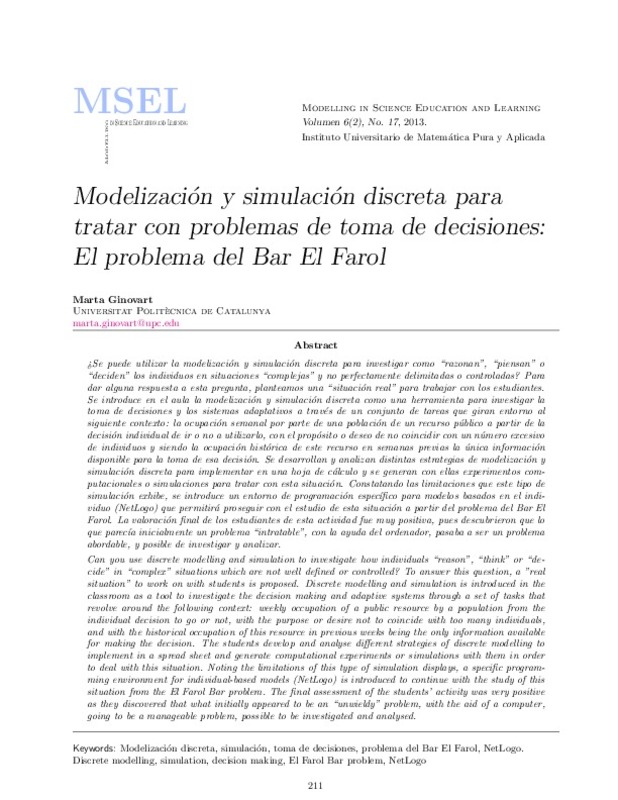JavaScript is disabled for your browser. Some features of this site may not work without it.
Buscar en RiuNet
Listar
Mi cuenta
Estadísticas
Ayuda RiuNet
Admin. UPV
Modelización y simulación discreta para tratar con problemas de toma de decisiones:El problema del Bar El Farol
Mostrar el registro sencillo del ítem
Ficheros en el ítem
| dc.contributor.author | Ginovart, Marta
|
es_ES |
| dc.date.accessioned | 2018-04-23T08:13:55Z | |
| dc.date.available | 2018-04-23T08:13:55Z | |
| dc.date.issued | 2013-06-02 | |
| dc.identifier.uri | http://hdl.handle.net/10251/100870 | |
| dc.description.abstract | [EN] Can you use discrete modelling and simulation to investigate how individuals “reason”, “think” or “decide” in “complex” situations which are not well defined or controlled? To answer this question, a “real situation” to work on with students is proposed. Discrete modelling and simulation is introduced in the classroom as a tool to investigate the decision making and adaptive systems through a set of tasks that revolve around the following context: weekly occupation of a public resource by a population from the individual decision to go or not, with the purpose or desire not to coincide with too many individuals, and with the historical occupation of this resource in previous weeks being the only information available for making the decision. The students develop and analyse different strategies of discrete modelling to implement in a spread sheet and generate computational experiments or simulations with them in order to deal with this situation. Noting the limitations of this type of simulation displays, a specific programming environment for individual-based models (NetLogo) is introduced to continue with the study of this situation from the El Farol Bar problem. The final assessment of the students' activity was very positive as they discovered that what initially appeared to be an “unwieldy” problem, with the aid of a computer, going to be a manageable problem, possible to be investigated and analysed. | es_ES |
| dc.description.abstract | [ES] ¿Se puede utilizar la modelización y simulación discreta para investigar como “razonan”, “piensan” o “deciden” los individuos en situaciones “complejas” y no perfectamente delimitadas o controladas? Para dar alguna respuesta a esta pregunta, planteamos una “situación real” para trabajar con los estudiantes. Se introduce en el aula la modelización y simulación discreta como una herramienta para investigar la toma de decisiones y los sistemas adaptativos a través de un conjunto de tareas que giran en torno al siguiente contexto: la ocupación semanal por parte de una población de un recurso público a partir de la decisión individual de ir o no a utilizarlo, con el propósito o deseo de no coincidir con un número excesivo de individuos y siendo la ocupación histórica de este recurso en semanas previas la única información disponible para la toma de esa decisión. Se desarrollan y analizan distintas estrategias de modelización y simulación discreta para implementar en una hoja de cálculo y se generan con ellas experimentos computacionales o simulaciones para tratar con esta situación. Constatando las limitaciones que este tipo de simulación exhibe, se introduce un entorno de programación específico para modelos basados en el individuo (NetLogo) que permitirá proseguir con el estudio de esta situación n a partir del problema del Bar El Farol. La valoración final de los estudiantes de esta actividad fue muy positiva, pues descubrieron que lo que parecía inicialmente un problema “intratable”, con la ayuda del ordenador, pasaba a ser un problema abordable, y posible de investigar y analizar. | es_ES |
| dc.language | Español | es_ES |
| dc.publisher | Universitat Politècnica de València | |
| dc.relation.ispartof | Modelling in Science Education and Learning | |
| dc.rights | Reconocimiento - No comercial (by-nc) | es_ES |
| dc.subject | Modelización discreta | es_ES |
| dc.subject | Simulación | es_ES |
| dc.subject | Toma de decisiones | es_ES |
| dc.subject | Problema del Bar El Farol | es_ES |
| dc.subject | NetLogo | es_ES |
| dc.subject | Discrete modelling | es_ES |
| dc.subject | Simulation | es_ES |
| dc.subject | Decision making | es_ES |
| dc.subject | El Farol Bar problem | es_ES |
| dc.title | Modelización y simulación discreta para tratar con problemas de toma de decisiones:El problema del Bar El Farol | es_ES |
| dc.type | Artículo | es_ES |
| dc.date.updated | 2018-04-20T07:45:59Z | |
| dc.identifier.doi | 10.4995/msel.2013.1947 | |
| dc.rights.accessRights | Abierto | es_ES |
| dc.description.bibliographicCitation | Ginovart, M. (2013). Modelización y simulación discreta para tratar con problemas de toma de decisiones:El problema del Bar El Farol. Modelling in Science Education and Learning. 6(2):211-233. https://doi.org/10.4995/msel.2013.1947 | es_ES |
| dc.description.accrualMethod | SWORD | es_ES |
| dc.relation.publisherversion | https://doi.org/10.4995/msel.2013.1947 | es_ES |
| dc.description.upvformatpinicio | 211 | es_ES |
| dc.description.upvformatpfin | 233 | es_ES |
| dc.type.version | info:eu-repo/semantics/publishedVersion | es_ES |
| dc.description.volume | 6 | |
| dc.description.issue | 2 | |
| dc.identifier.eissn | 1988-3145 | |
| dc.description.references | W. B. Arthur. Inductive Reasoning and Bounded Rationality. American Economic Review 84, 406-411 (1994). | es_ES |
| dc.description.references | N. Gilbert, K. G. Troitzsch. Simulation for the social scientist. 2nd edition. Open University Press (2005). | es_ES |
| dc.description.references | M. Ginovart, X. Portell, P. Ferrer-Closas, M. Blanco. Modelos basados en el individuo y la plataforma NetLogo. UNIÓN-Revista Iberoamericana de Educación Matemática 27, 131-150 (2011). | es_ES |








